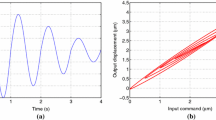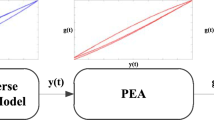Abstract
Micro/nano positioning technologies have been attractive for decades in industrial and scientific applications fields. The actuators have inherent hysteresis that can cause system unexpected behave in some extend. In this research, the authors used extented unparallel Prandtl-Ishlinshii (EUPI) models to represent the input-output relationship of a piezo-driven micro position stage. Integral inverse (I-I) compensator is used for compensating the hysteresis characteristics of the micro positioning stage and compared with direct inverse (D-I) compensator and inverse model (I-M) compensator. However, the accuracy and the robustness of the I-I compensator are worse when there is noisy in the system, a novel sliding-mode-like-control with EUPI (SMLC-EUPI) method was proposed and analyzed by different trajectory tracking experiments in Matlab environment. Though the above strategies can alleviate most deviation, the adjustment of the SMLC’s parameters is very complex. So the fuzzy method is used to adjust these parameters and be verified by trajectory tracking experiments. Finally, for validating the proposed control method, the paper did the corresponding experiment in microscope with CMOS and obtained convincing results.
Similar content being viewed by others
References
Yang R, Song B, Sun Z, et al., Cellular level robotic surgery: Nanodissection of intermediate filaments in live keratinocytes, Nanomedicine: Nanotechnology, Biology and Medicine, 2015, 11(1): 137–145.
Nelson B J, Dong L, and Arai F, Micro-/Nanorobots, Springer Handbook of Robotics, Springer, Cham, 2016, 671–716.
Liu W, Cheng L, Zhou C, et al., Neural-network based model predictive control for piezoelectric-actuated stick-slip micro-positioning devices, IEEE International Conference on Advanced Intelligent Mechatronics (AIM), 2016, 1312–1317.
Choi K B, Lee, and J J, Analysis and design of linear parallel compliant stage for ultra-precision motion based on 4-PP flexural joint mechanism, International Conference on Smart Manufacturing Application, 2008, 35–38.
Lin S, Jia Y, Lei I P, et al., Design and optimization of a long-stroke compliant micropositioning stage driven by voice coil motor, 12th International Conference on Control Automation Robotics & Vision (ICARCV), 2012, 1716–1721.
Qi Q and Du R, A vision based micro-assembly system for assembling components in mechanical watch movements, International Symposium on Optomechatronic Technologies (ISOT), 2010, 1–5.
Kunt E D, Naskali A T, Khalil I S M, et al., Design and development of workstation for microparts manipulation and assembly, Turkish Journal of Electrical Engineering & Computer Sciences, 2011, 19(6): 973–992.
Wu Z and Xu Q, Design and optimization of a compact XY parallel micro/nano-positioning stage with stacked structure, 2nd International Conference on Advanced Robotics and Mechatronics (ICARM), 2017, 558–563.
Hao L N and Cao R M, A Large-Workspace Fast Response X-Y Micro-Plantform with Two Parallel Displacement Amplification Mechanism, CN105006254A.
Cao R M, Mechanism and Measurement & Control System Design of Micro-Positioning Piezo-Stage Actuated by PZT, Northeastern University of China, Shenyang, 2016.
Jaffe B, Piezoelectric Ceramics, Elsevier, 2012.
Damjanovic D, Hysteresis in piezoelectric and ferroelectric materials, The Science of Hysteresis, 2006, 3: 337–465.
Esbrook A, Tan X, and Khalil H K, Control of systems with hysteresis via servocompensation and its application to nanopositioning, IEEE Transactions on Control Systems Technology, 2013, 21(3): 725–738.
Kenton B J and Leang K K, Design and control of a three-axis serial-kinematic high-bandwidth nanopositioner, IEEE/ASME Transactions on Mechatronics, 2012, 17(2): 356–369.
Li Y and Xu Q, Design and robust repetitive control of a new parallel-kinematic XY piezostage for micro/nanomanipulation, IEEE/ASME Transactions on Mechatronics, 2012, 17(6): 1120–1132.
Janaideh M A, Rakheja S, and Su C Y, An analytical generalized Prandtl-Ishlinskii model inversion for hysteresis compensation in micropositioning control, IEEE/ASME Transactions on Mechatronics, 2011, 16(4): 734–744.
Li Z, Su C Y, and Chai T, Compensation of hysteresis nonlinearity in magnetostrictive actuators with inverse multiplicative structure for Preisach model, IEEE Transactions on Automation Science and Engineering, 2014, 11(2): 613–619.
Sun Z, Song B, Xi N, et al., Compensating asymmetric hysteresis for nanorobot motion control, IEEE International Conference on Robotics and Automation (ICRA), 2015, 3501–3506.
Sun Z Y, Chen L L, Song B, et al., Asymmetric hysteresis modeling and compensation approach for nanomanipulation system motion control considering working-range effect, IEEE Transactions on Industrial Electronics, 2017, 64(7): 5513–5523.
Sun Z, Xi N, Cheng Y, et al., Exact inversion of discrete Preisach model for compensating complex hysteresis in AFM based nanomanipulator, IEEE 17th International Conference on Nanotechnology (IEEE-NANO), 2017.
Sun Z, Cheng Y, Xi N, et al., Frequency domain approach for dynamics identification of the actuator with asymmetric hysteresis, IEEE International Conference on Advanced Intelligent Mechatronics (AIM), 2017, 364–369.
Yang Y, Xi N, Sun Z, et al., Nanorobot enabled in situ sensing molecular interactions for drug discovery, IEEE/RSJ International Conference on Intelligent Robots and Systems (IROS), 2016, 5285–5290.
Sun Z, Song B, Xi N, et al., Systematic hysteresis compensator design based on extended unparallel Prandtl-Ishlinskii model for SPM imaging rectification, IFAC-PapersOnLine, 2017, 50(1): 10901–10906.
Sun Z, Hao L, Song B, et al., Periodic reference tracking control approach for smart material actuators with complex hysteretic characteristics, Smart Materials and Structures, 2016, 25(10): 105029.
Xiang C, Yang H, Sun Z, et al., The design, hysteresis modeling and control of a novel SMA-fishing-line actuator, Smart Materials and Structures, 2017, 26(3): 037004.
Hao L, Yang H, Sun Z, et al., Modeling and compensation control of asymmetric hysteresis in a pneumatic artificial muscle, Journal of Intelligent Material Systems and Structures, 2017, 28(19): 2769–2780.
Sun Z, Hao L, Chen W, et al., A novel discrete adaptive sliding-mode-like control method for ionic polymer-metal composite manipulators, Smart Materials and Structures, 2013, 22(9): 095027.
Song G, Zhao J, Zhou X, et al., Tracking control of a piezoceramic actuator with hysteresis compensation using inverse Preisach model, IEEE/ASME Transactions on Mechatronics, 2005, 10(2): 198–209.
Xia S and Li Y, Modeling and high dynamic compensating the rate-dependent hysteresis of piezoelectric actuators via a novel modified inverse Preisach model, IEEE Transactions on Control Systems Technology, 2013, 21(5): 1549–1557.
Gan M G, Qiao Z, and Li Y L, Sliding mode control with perturbation estimation and hysteresis compensator based on bouc-wen model in tackling fast-varying sinusoidal position control of a piezoelectric actuator, Journal of Systems Science & Complexity, 2016, 29(2): 367–381.
Zhang Y and Xu Q, Adaptive sliding mode control with parameter estimation and kalman filter for precision motion control of a piezo-driven microgripper, IEEE Transactions on Control Systems Technology, 2017, 25(2): 728–735.
Xu Q, Precision motion control of piezoelectric nanopositioning stage with chattering-free adaptive sliding mode control, IEEE Transactions on Automation Science and Engineering, 2017, 14(1): 238–248.
Xu Q, Continuous integral terminal third-order sliding mode motion control for piezoelectric nanopositioning system, IEEE/ASME Transactions on Mechatronics, 2017, 22(4): 1828–1838.
Janaideh M A, Rakotondrabe M, and Aljanaideh O, Further results on hysteresis compensation of smart micropositioning systems with the inverse prandtl-ishlinskii compensator, IEEE Transactions on Control Systems Technology, 2016, 24(2): 428–439.
Tang H and Li Y, Feedforward nonlinear PID control of a novel micromanipulator using Preisach hysteresis compensator, Robotics and Computer-Integrated Manufacturing, 2015, 34: 124–132.
Rana M S, Pota H R, and Petersen I R, Approach for improved positioning of an atomic force microscope piezoelectric tube scanner, Micro & Nano Letters, 2014, 9(6): 407–411.
Zhou M, He S, Hu B, et al., Modified KP model for hysteresis of magnetic shape memory alloy actuator, IETE Technical Review, 2015, 32(1): 29–36.
Zhang Y, Yan P, and Zhang Z, Robust adaptive backstepping control for piezoelectric nano-manipulating systems, Mechanical Systems and Signal Processing, 2017, 83: 130–148.
Li L, Song G, and Ou J, Adaptive fuzzy sliding mode based active vibration control of a smart beam with mass uncertainty, Structural Control and Health Monitoring, 2011, 18(1): 40–52.
Li P, Li P, and Sui Y, Adaptive fuzzy hysteresis internal model tracking control of piezoelectric actuators with nanoscale application, IEEE Transactions on Fuzzy Systems, 2016, 24(5): 1246–1254.
Author information
Authors and Affiliations
Corresponding author
Additional information
This work was supported by the National Natural Science Foundation of China under Grant Nos. 61573093 and U1613205.
This paper was recommended for publication by Editor SUN Jian.
Rights and permissions
About this article
Cite this article
Gao, J., Hao, L., Cheng, H. et al. Simulation and Experiment Based on FSMLC Method with EUPI Hysteresis Compensation for a Piezo-Driven Micro Position Stage. J Syst Sci Complex 32, 1340–1357 (2019). https://doi.org/10.1007/s11424-018-7314-6
Received:
Revised:
Published:
Issue Date:
DOI: https://doi.org/10.1007/s11424-018-7314-6




